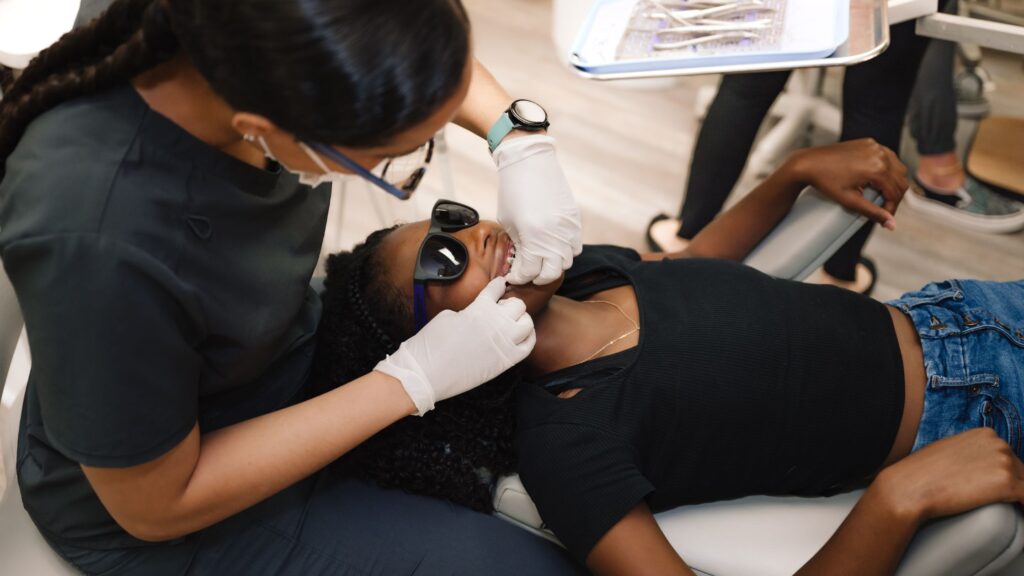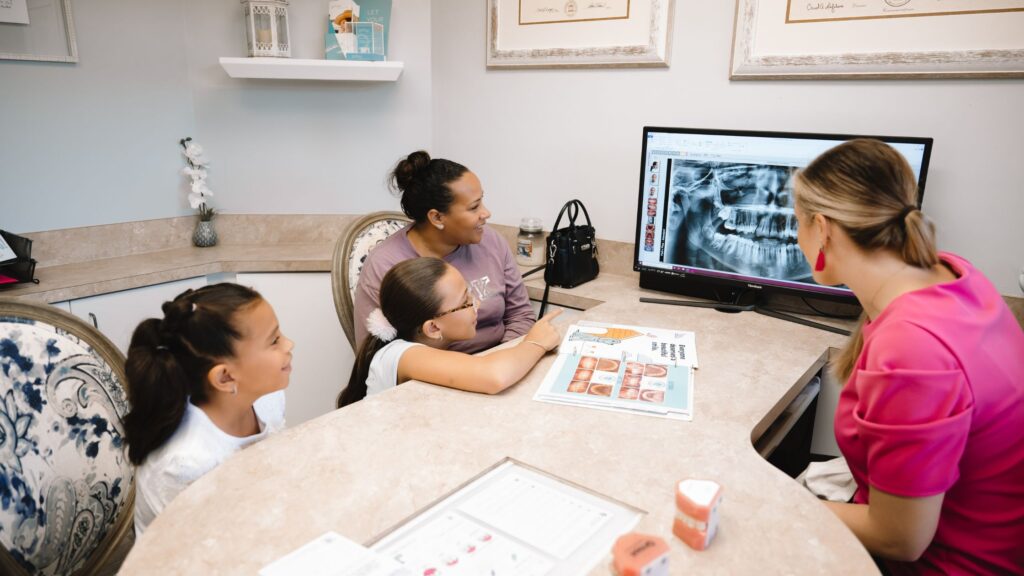No matter whether you’re a kid, a teen, or an adult, you’ll need follow-up appointments after getting metal braces. It’s necessary to meet up with your Port Orange orthodontist on a regular basis to make sure you’re getting the desired results from your braces.
These appointments are important because braces are always at work moving your teeth gently from their current position into the healthier treated position. Your orthodontist needs to verify the process works exactly as intended. That helps you see the results in the mirror faster.
You’ve probably heard these appointments referred to as “wire tightening” or even “wire changing.”
The technical term is wire sequencing since the wires don’t actually get replaced at any point unless they’re damaged. You will have the same wires and brackets all throughout your orthodontic care, but your orthodontist does need to make changes so they will continue to work as expected.
The network of wires and metal brackets that make up your braces are carefully designed to exert gentle pressure. Too little pressure and your teeth would not move at all or else go very slowly. Too much and the changes would be too rapid. Your mouth needs time to adjust.
So, during these appointments, three things happen:
1. Your Orthodontist Checks on Your Current Progress
At the beginning of your orthodontic care, you’ll usually get full digital imaging done of your teeth. This is necessary to make sure progress can be tracked in the future. If you opt for clear plastic aligners over metal braces, then these images are used to fabricate aligners, especially for your mouth.
It’s no exaggeration that braces have been used successfully by millions of people all over the world. That includes four million Americans, and 25% of those are adults. The effectiveness of braces is a sure thing! They just need a little bit of care along the way to get where they are going.
For most patients, the positive changes expected from braces develop at a steady pace. It only takes a few minutes at the beginning of your appointment to verify that you are on track. Your orthodontist is trained to use this information to keep you going strong with your treatment.
2. Your Orthodontist Updates Your Braces’ Wire Tension
One reason it’s so vital to have orthodontic appointments for braces is because the wires may need to be adjusted. These periodic adjustments deliver the right level of pressure to continue the movement of teeth. As the teeth move, it becomes necessary to account for their new positioning.
The process of updating braces is quick and painless. It may take anywhere from ten minutes to half an hour, although it tends to be on the faster side. You should never feel discomfort from your braces. You might, however, feel a little soreness in the first week of having braces – that should quickly go away.
It might seem pesky to have to see your Port Orange orthodontist regularly, but it is worth it. Needing an adjustment is actually a good sign, showing that your teeth are responding well to treatment. If you put off an adjustment, it may mean you’ll need to wear your braces longer to complete your care.
3. Your Orthodontist Helps with Any Issues or Questions
Any orthodontist appointment is all about you and your needs. No matter the age of the patient, you might have plenty of questions – and you deserve to have them all answered. Dr. Beauchamp will give you all the information you need on the way to your healthy and happy smile.
Most patients experience no complications with braces, but accidents do happen, and you might end up with a damaged wire or bracket. There are lots of easy home fixes for braces that can help you between appointments. However, Dr. Beauchamp will make sure the issue is completely solved.
Remember, even though you have an appointment scheduled, it doesn’t mean you can’t come in earlier. We encourage our patients to call in any time they need advice. If you are in any pain or discomfort as a result of damage to your braces, it is a wise idea to visit the office as soon as you can.
A Sample Timeline of Orthodontic Appointments for Braces
No matter your age or how severe your orthodontic condition is, you’ll definitely need to follow up. But exactly how frequent those appointments are varies. While every patient is different, there’s a usual schedule that these appointments often fall into.
Let’s take a look at what many patients can expect:
1. At the Beginning of Care
At the start of care, there’s an ordinary adjustment period. In the first week, it’s essential to be alert to any unusual sensations. Most braces are fitted perfectly the very first time, but there may need to be an early adjustment. Getting this part right lays the foundation for your success in the future.
Once the braces are in place and properly adjusted, your teeth start responding to treatment at their fastest. The pace of change means that you will need to follow up more frequently at this point than others. It’s not unusual to have an appointment every month in the beginning.
Some patients who have very significant orthodontic issues or have dental concerns that present at the same time may need to visit every two weeks, at least for the first while. Pretty soon, however, many patients settle into a rhythm of appointments every month or so, and these gradually slow down.
This early phase usually lasts for about the first three months, but it all depends:
- How fast your teeth start responding to treatment can change your timeline
- Older patients generally wait longer before noticeable change starts to happen
- Younger patients are typically done a few months sooner than their elders are
While various factors can affect your braces, you never need to worry that they’re not working. Braces have been around in some form for hundreds of years and Dr. Beauchamp knows them backward and forwards. It just takes a while for your teeth and gums to get the party started.
2. In the Middle of Care
After this opening phase, you’re well on your way to the strong and healthy teeth you want. Gaps and crooked or crowded teeth start to resolve themselves according to your treatment plan. The pace of follow-up appointments tends to slow down as everything settles in.
In the middle of your orthodontic care, you’ll usually get a little more time between appointments. That can be anywhere from every six weeks to every two months. It might be necessary to take more images of your mouth and teeth so your orthodontist can see the whole picture (and show you the difference!)
In the middle of care, it becomes easier and easier to notice the difference with your teeth. Sometimes, this can be a little bit alarming. It might feel like your teeth are a little bit looser than before. In truth, healthy teeth do have a little bit of “wiggle room,” and this is nothing to be worried about.
At this stage, you might not be able to see the total picture of how your teeth are shifting when you look in the mirror. But if you have crowded teeth, you might start noticing changes there. As they take place, be careful to change your brushing habits so you’re getting all the surfaces that you can reach.
Since there’ll be fewer appointments on your schedule, it’s even more crucial to reach out to your Port Orange orthodontist if anything happens. At this stage, damage to your braces can add weeks to your treatment time. Getting those mishaps settled quickly will keep you moving forward!
3. Near the End of Care
As you get closer to the end of your treatment, you might be asked to schedule more appointments than before, closer to the once-a-month mark. This is to make certain that you reach the results you want and don’t end up wearing braces any longer than you need to.
At this stage, you’ll start discussing post-braces care with your orthodontist. Life after braces includes a retainer for many patients. A retainer is an orthodontic appliance that helps you keep your teeth in the treated position. Some patients may not need it, but it is good to know about it!
Finally, the big day comes when you are able to get your braces removed. Removal takes one visit and can last anywhere from twenty minutes to an hour. A final x-ray is sometimes taken at this point to keep your dental records updated and monitor your teeth after treatment.
Do Older Patients Need Their Braces Examined More Often?
Do older patients need more appointments for braces? Yes and no.
Older patients may be in treatment longer, which means they will have more appointments overall. But that doesn’t necessarily mean they’ll need more frequent appointments. Your overall dental health is a big factor in whether you should follow up more than the average patient.
Young patients with relatively minor issues could be in treatment for less than six months, while older patients with long-term concerns may wear braces for two years or more. No matter who you are and what your background is, though, braces are best for the biggest orthodontic care challenges.
If you are concerned about the length of time you’ll be in braces, be sure to ask Dr. Beauchamp about clear plastic aligners. Adults and image-conscious teens alike love clear plastic aligners thanks to their subtlety. They’re so discreet, your orthodontist may be the only one who knows you have them.
All in all, there’s a nearly zero risk of side effects from conventional metal braces no matter your age. Dr. Beauchamp will be glad to help you lay any concerns to rest before you decide about braces for you or your family. We are all about helping you stay as comfortable as possible throughout the journey!
Get Your Braces from a Trusted Port Orange Orthodontist
Once you get braces, it’s best to stick with your orthodontist. Starting over with someone else could mean treatment takes longer. At Beauchamp Orthodontics, we want to help you make the decision with confidence. We are here for you and your loved ones from start to finish.
At our fun, family-friendly office, we take the stress out of orthodontic care. Our team is dedicated to giving you the best experience you’ve ever had in the treatment chair.
Schedule a consultation to get started today. We look forward to helping you!



